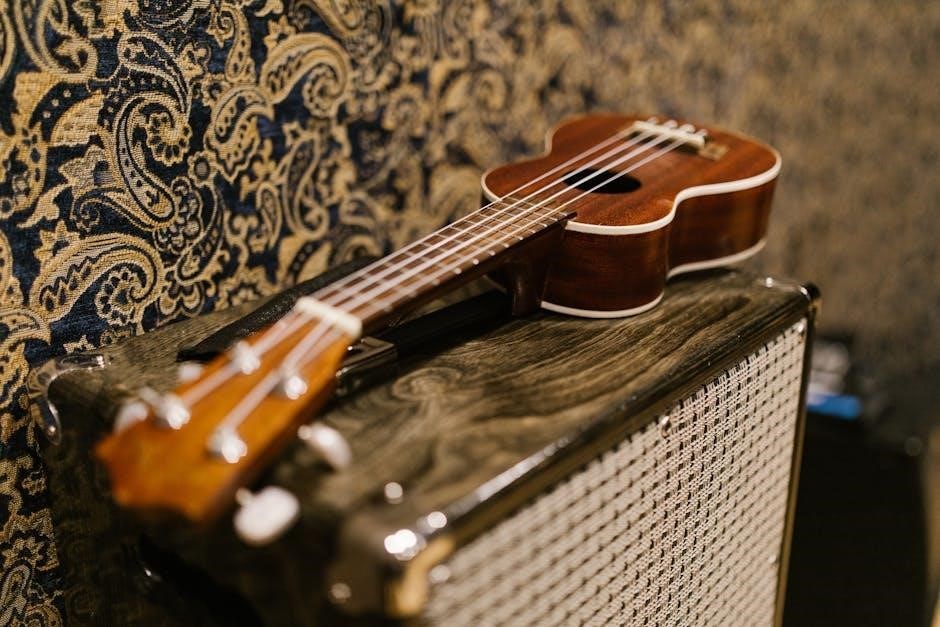Guitar string gauge refers to the thickness of each string, measured in thousandths of an inch. It significantly impacts playability, tone, and tuning stability. Lighter gauges are easier for strumming, while heavier gauges offer fuller sound and better sustain. Choosing the right gauge depends on personal preference, playing style, and the type of guitar. Understanding string gauge is essential for optimizing your instrument’s performance and ensuring a comfortable playing experience.
What is String Gauge?
String gauge refers to the thickness of a guitar string, measured in thousandths of an inch. It is an essential factor in determining a guitar’s playability, tone, and tuning stability. Lighter gauges, such as 0.010 to 0.046, are easier to press and bend, making them ideal for strumming and lead playing. Heavier gauges, like 0.012 to 0.052, provide a fuller sound and better sustain, often preferred by rhythm and bass players. The gauge is typically indicated on the packaging of string sets, with the lightest and heaviest strings highlighted. Understanding string gauge is crucial for tailoring your guitar’s setup to your playing style and musical preferences.
- Common gauges for electric guitars: 0.010 to 0.046
- Common gauges for acoustic guitars: 0.012 to 0.052
Importance of String Gauge in Guitar Playing
String gauge significantly impacts both the sound and playability of a guitar. Thinner strings produce a brighter tone and are easier to bend, making them ideal for techniques like lead playing. Heavier strings, while harder to press down, offer better sustain and volume, often preferred for rhythm and bass roles. The choice of gauge affects tuning stability, with heavier strings generally staying in tune better, especially during string bending or tremolo use. Different genres may favor specific gauges, such as jazz using heavier strings for a fuller sound and rock or metal opting for lighter strings for faster solos. Personal comfort and playing style also influence gauge selection, as lighter strings can reduce fatigue during long sessions. Ultimately, the right gauge balances tone preferences with ease of playability, making it a crucial factor in a guitarist’s setup.

Factors Influencing String Gauge Selection
The primary factors influencing string gauge selection include playability, tone preferences, tuning stability, and personal comfort. These elements help determine the ideal gauge for various playing styles.
Playability and Comfort
String gauge significantly impacts playability and comfort, as lighter gauges are easier on the fingers and require less strength for bending and pressing. Lighter strings are ideal for players with smaller hands or those who prefer smoother, faster playing styles. Heavier gauges, while offering a fuller tone, demand more finger strength and can be challenging for beginners or those with less hand strength. Players often choose lighter gauges for strumming and lead work, while heavier gauges suit rhythm and bass playing. Balancing gauge with personal comfort ensures a more enjoyable and efficient playing experience, allowing musicians to focus on their technique and creativity.
Tone and Sound Preferences
String gauge plays a crucial role in shaping the tone and sound of a guitar. Lighter gauges produce a brighter, crisper tone with enhanced clarity, making them ideal for lead guitarists and intricate playing styles. Thinner strings vibrate more quickly, delivering a sharp, snappy sound. Conversely, heavier gauges yield a warmer, richer tone with increased sustain, often preferred by rhythm and bass players. The heavier strings produce a fuller sound due to their greater mass, which enhances low-end response and overall resonance. Players can tailor their string choice to match their musical genre and desired sound, ensuring the optimal balance between tone quality and playability.
Tuning Stability

Tuning stability is significantly influenced by string gauge, as thicker strings are generally more stable due to their increased mass and rigidity. Heavier gauges vibrate less unpredictably, reducing the likelihood of pitch fluctuations during performance. Conversely, lighter strings are more prone to detuning, especially under aggressive playing or environmental changes. New strings often require a break-in period to settle and maintain consistent tuning. Players can improve stability by stretching strings during installation and ensuring proper setup. Climate and humidity also play a role, as changes in temperature and moisture can affect string tension and tuning accuracy. Choosing the right gauge helps balance stability with playability, ensuring reliable performance across various playing conditions and musical styles.
Common Guitar String Gauges
Guitar string gauges vary widely, offering options for different playing styles and tonal preferences. Common gauges range from light (.009-.042) to heavy (.012-.052), with medium sets being popular for balance. Lighter gauges facilitate easier bending and faster solos, while heavier gauges provide fuller tones and sustain, ideal for rhythm and bass. Acoustic guitars often use medium to heavy gauges for projection, whereas electric guitars lean toward lighter gauges for lead work. Understanding these options helps players tailor their sound and comfort to their musical needs. proper selection can enhance performance and overall satisfaction.
Electric Guitar String Gauges
Electric guitar string gauges typically range from super light (.008-.038) to heavy (.011-.052). Lighter gauges (.009-.042) are popular for lead playing, offering easier bending and a brighter tone. Medium gauges (.010-.046) provide a balanced feel, suitable for both rhythm and lead, while heavier gauges (.011-.052) deliver a fuller sound and increased sustain, ideal for rhythm and palm-muted styles. Many players prefer lighter strings for faster solos, while heavier gauges are favored in genres like metal for their robust tone. Common sets include 9s, 10s, and 11s, with 10s being a versatile choice for most electric guitarists. These gauges cater to various musical styles and techniques, ensuring optimal performance and tone.
Acoustic Guitar String Gauges
Acoustic guitar string gauges generally range from extra light (.010-.047) to medium (.011-.052) and heavy (.012-.053). Extra light strings are ideal for beginners or fingerstyle players, offering easier playability. Medium gauges provide a balanced tone and are versatile for various playing styles. Heavy gauges are often used by professional musicians for a fuller, richer sound and increased sustain. Lighter gauges are easier on the fingers but may lack volume and projection, while heavier gauges deliver more resonance but require more finger strength. Common setups include 10s (.010-.047) for a bright, easy feel and 12s (.012-.053) for a robust, dynamic tone. Choosing the right gauge enhances both sound quality and playing comfort.

How String Gauge Affects Playing Style
String gauge influences comfort and technique, with lighter gauges aiding strumming and lead, while heavier gauges suit rhythm and bass, requiring more strength and precision.
Lighter Gauges for Strumming and Lead
Lighter string gauges, such as 0.010 to 0.046, are ideal for strumming and lead playing due to their ease of playability. Thinner strings require less finger strength, allowing for smoother, faster movements across the fretboard. This makes them perfect for intricate solos and chord progressions. Lighter gauges also produce a brighter, more articulate tone, enhancing clarity in high-pitched melodies. However, they may lack the sustain and depth of heavier strings. For lead guitarists, lighter gauges are often preferred as they enable easier string bending and vibrato. Additionally, they reduce fatigue during extended playing sessions, making them a popular choice for players prioritizing speed and agility over heavy, resonant tones.

Heavier Gauges for Bass and Rhythm
Heavier string gauges, typically ranging from 0.011 to 0.052 or higher, are well-suited for bass and rhythm playing. These thicker strings produce a fuller, warmer tone with enhanced sustain, making them ideal for rhythm sections and basslines. The increased string tension provides better stability and resonance, especially in lower frequencies. Heavier gauges are also preferred by players who use aggressive playing styles, as they can withstand heavier picking and strumming without losing clarity. However, they require more finger strength and may cause fatigue for beginners. Despite this, heavier gauges deliver a robust, dynamic sound that is often favored by rhythm and bass players seeking a powerful, resonant tone.
Measuring String Gauge
Measuring string gauge accurately requires a micrometer, ensuring precise thickness readings essential for proper guitar string setups and adjustments. It guarantees accurate results.
Using a Micrometer for Accurate Measurement
A micrometer is a precise tool for measuring string gauge, ensuring accurate readings. To use it, place the string between the micrometer’s measuring surfaces and gently tighten until it fits snugly. This method provides exact thickness measurements, essential for matching desired gauges. Guitar shops often use micrometers during setups, but players can also purchase one for personal use. Accurate measurement prevents tuning issues and ensures optimal playability. Using a micrometer guarantees consistency, making it a valuable tool for both professionals and hobbyists. Proper measurement is crucial for achieving the best sound and performance from your guitar.

Personal Preference and Setup
Personal preference significantly influences string gauge selection, with players often experimenting to find their ideal setup. Lighter gauges suit strumming, while heavier gauges enhance tone and sustain.
Examples of Common String Gauge Setups
Common string gauge setups vary based on guitar type and player preference. For electric guitars, 10-46 (Regular Slinkies) and 11-48 (Power Slinkies) are popular choices. Acoustic guitars often use 12-52 or 10-47. Many players start with lighter gauges like .010-.046 for easier playability. Heavier gauges, such as .011-.052, are favored for fuller tone and sustain. Steel-string acoustics typically range from .010-.013 (extra light) to .012-.054 (medium). Classical guitars often use nylon strings with lighter gauges. These setups serve as starting points, but players often adjust gauges to suit their style and sound preferences. Experimenting with different gauges helps find the ideal balance between tone, playability, and comfort.

Switching String Gauges
Switching string gauges requires adjustments to ensure proper playability and tone. Use a micrometer to measure thickness accurately. A professional setup may be necessary for optimal results.
Adjustments Needed for Different Gauges
When switching string gauges, several adjustments are necessary to maintain optimal playability and tone. The bridge and nut must be checked to ensure proper string height and action. Heavier gauges may require a higher action to prevent buzzing, while lighter gauges can be set lower for easier playing. Additionally, the truss rod may need adjustment to compensate for the added or reduced tension. Using a micrometer ensures precise measurements, and a professional setup is often recommended for best results. These adjustments ensure the guitar remains comfortable to play and sounds its best with the new string gauge.
Tools and Techniques for a Proper Setup
Properly setting up your guitar with new string gauges requires specific tools and techniques. A micrometer is essential for accurately measuring string thickness, ensuring the correct gauge is used. An Allen wrench or screwdriver is needed to adjust the truss rod, which compensates for string tension changes. A bridge adjustment tool helps set the correct string height and intonation. Techniques include precise measurement, gradual tension adjustments, and checking string action at multiple frets. Avoid over-tightening, as it can damage the neck. Using these tools and methods ensures a smooth transition to a new string gauge, maintaining playability and tone. Professional setup is recommended for optimal results.
Choosing the right string gauge balances playability, tone, and personal preference. Experiment with different gauges to find your ideal setup, ensuring optimal performance and comfort for your playing style.
Final Thoughts on Choosing the Right String Gauge
Selecting the ideal string gauge is a personal journey that depends on your playing style, musical genre, and guitar type. Lighter gauges, such as 0.010-0.046, are perfect for strumming and lead work, offering ease of playability and a bright tone. Heavier gauges, like 0.011-0.052, suit rhythm and bass players, providing a fuller sound and better sustain. It’s crucial to experiment with different sets to find the balance that complements your technique and enhances your music. Remember, the right gauge will not only improve your performance but also make playing more enjoyable and rewarding.